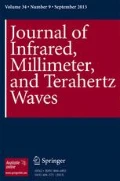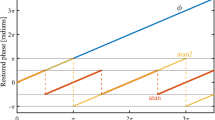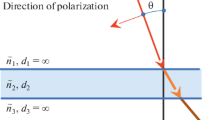Abstract
Inherent to transmission/reflection measurement methods and posed by the multiple-valued logarithm function of the complex transmission coefficient, the phase ambiguity problem is solved by the phase wrapping technique. Here extended and generalized, the proposed technique relies on properly adding to the phase of the complex logarithmic function a stepwise function built in from the resonance frequencies at which the phase of the transmission coefficient reaches ±π. In a concrete example the method is illustrated by correctly retrieving from complex scattering parameters the constitutive parameters of a highly-dispersive medium (distilled water) over the 0–250 GHz frequency range. Implication of a mathematically negative wavelength is also discussed.








Similar content being viewed by others
References
C. Hasar and C.R. Westgate, “A broadband and stable method for unique complex permittivity determination of low-loss materials,” IEEE Trans. Microw. Theory Tech.. 57(2), 471 (2009).
J. Baker − Jarvis, E. J. Vanzura, and W. A. Kissick, “Improved technique for determining complex permittivity with the transmission/reflection method,” IEEE Trans. Microw. Theory Tech. 38(8), 1096–1103 (1990).
A.-H. Boughriet, C. Legrand, and A. Chapoton, “Noniterative stable transmission/reflection method for low-loss material complex permittivity determination,” IEEE Trans. Microw. Theory Tech. 45(1) 52 (1997).
U. C. Hasar, “A new microwave method based on transmission scattering parameter measurements for simultaneous broadband and stable permittivity and permeability determination,” Progr. Electromagn. Res. PIER 93, 161 (2009).
K. Chalapat, K., K. Sarvala, J. Li, and G. S. Paraoanu, “Wideband reference-plane invariant method for measuring electromagnetic parameters of materials,” IEEE Trans. Microw. Theory Tech.. 57(9), 2257 (2009).
M. Nicolson and G. F. and Ross, “Measurement of the intrinsic properties of materials by time-domain”, IEEE Trans. Instrum. Meas. IM-19(4), 377 (1970).
Hasar, U. C., “A microwave method for noniterative constitutive parameters determination of thin low-loss or lossy materials,” IEEE Trans. Microw. Theory Tech. 57(6), 1595 (2009).
W. B. Weir, “Automatic measurement of complex dielectric constant and permeability at microwave frequencies,” Proc. IEEE 62(1), 33 (1974).
U. C. Hasar, “Elimination of the multiple-solutions ambiguity in permittivity extraction from transmission-only measurements of lossy materials”, Microw. Opt. Techn. Let. 51(2), 337 (2009).
X. Chen, T. M. Gregorczyk, B.-I. Wu, J. Pacheco, Jr., and J. A. Kong, “Robust method to retrieve the constitutive effective parameters of metamaterials,” Phys. Rev. E, Stat. Phys. Plasmas Fluids Relat. Interdiscip. Top. 70, 016608 (2004).
V. V. Varadan, and R. Ro, “Unique retrieval of complex permittivity and permeability of dispersive materials from reflection and transmitted fields by enforcing causality,” IEEE Trans. Microw. Theory Tech. 55(10), 2224 (2007).
Z. Szabó, G.-H. Park, R. Hedge, and E.-P. Li, “A unique extraction of metamaterial parameters based on Kramers-Kronig relationship”, IEEE Trans. Microw. Theory Tech. 58(10), 2646 (2010).
L. F. Chen, C. K. Ong, C. P. Neo, V. V. Varadan, and V. K. Varadan, Microwave Electronics: Measurement and Materials Characterization. (Wiley, West Sussex, U. K., 2004), p. 178.
L. D. Landau, E. M. Lifshitz, and L. P. Pitaevskii, Electrodynamics of Continuous Media, 2nd. edn. (Pergamon, Oxford, 1984), p. 279.
W. J. Ellison, K. Lamkaouchi, and J.-M. Moreau, “Water: a dielectric reference”, Journal of Molecular Liquids 68, 171 (1996).
Acknowledgment
One of the authors (JJB) would like to thank CNPq, Brazil, for support.
Author information
Authors and Affiliations
Corresponding author
Rights and permissions
About this article
Cite this article
Barroso, J.J., Hasar, U.C. Resolving Phase Ambiguity in the Inverse Problem of Transmission /Reflection Measurement Methods. J Infrared Milli Terahz Waves 32, 857–866 (2011). https://doi.org/10.1007/s10762-011-9792-7
Received:
Accepted:
Published:
Issue Date:
DOI: https://doi.org/10.1007/s10762-011-9792-7




